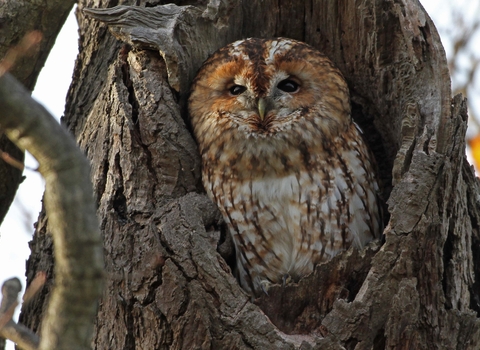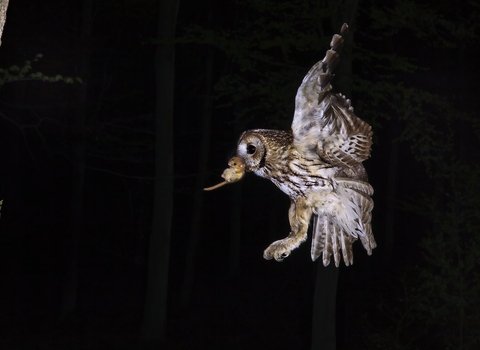
Tawny owl ©Margaret Holland
Tawny owl
Scientific name
Strix alucoWhen to see
January to DecemberSpecies information
Category
Statistics
Length: 37-39cmWingspan: 99cm
Weight: 420-520g
Average lifespan: 4 years
Habitats
About
Tawny owls are our biggest common owl, familiar in Britain’s woodland, parks and gardens. The‘too-wit too-woo’ call often referred to as being the song of the generic owl, is that of the tawny owl. But it isn’t the call of a single bird, but instead made by a male and female calling to each other.The female makes a ‘too-wit’ sound and the male answers with ‘too-woo’! These incredible creatures sit on their favourite perch on the lookout for small animals like voles and mice to eat. They nest during springtime in hollow trees, or sometimes choose to reuse an old crow’s nest!How to identify
The tawny owl is mottled reddish-brown, with a paler underside. It has a big, round head, rounded wings, large, dark eyes, and a dark ring around its face.Distribution
Widespread, but absent from Northern Ireland and the Isle of Man.In our area
Venture to any woodlands around Shropshire at dusk in the Autumn months and you are likely to hear the familiar call of the tawny owl. Parks and established gardens with old trees are often attractive places for tawny owls to settle as they provide decent cover and nesting potential. Ivy-covered trees are also ideal as the the evergreen parasitic plant provides an extra layer of shelter for the owls during winter. You don't need to venture far if you live in an urban area - tawny owls are regularly heard at places like Apley Park and Telford Town Park. Whitcliffe Common in Ludlow is home to a breeding pair and the hooting and tooting call is often heard along the Rea Brook nature reserve in Shrewsbury.
Like other birds of prey, tawny owl numbers vary from year to year depending on the availability of small rodents like field voles and wood mice. These mammals are sensitive to unstable weather conditions and changes in land use. During particularly harsh winters immediately following very dry summers, the number of small rodents often plummets, leaving tawny owls with little to sustain themselves. It is usually the Autumn that is the most productive time for hunting of mice and voles, as it is the end of the breeding season when their populations are at their highest.
Did you know?
Like other owls, tawny owl can famously turn their head through 270 degrees and are able to look behind them. Although owls have binocular vision, their forward-facing eyes cannot move in their sockets, so they must turn their heads instead.Watch
Tawny Owl (https://vimeo.com/453690105)
Tawny Owl by Tom Hibbert
Venture to any woodlands around Shropshire at dusk in the Autumn months and you are likely to hear the familiar call of the tawny owl. Parks and established gardens with old trees are often attractive places for tawny owls to settle as they provide decent cover and nesting potential. Ivy-covered trees are also ideal as the the evergreen parasitic plant provides an extra layer of shelter for the owls during winter. You don't need to venture far if you live in an urban area - tawny owls are regularly heard at places like Apley Park and Telford Town Park. Whitcliffe Common in Ludlow is home to a breeding pair and the hooting and tooting call is often heard along the Rea Brook nature reserve in Shrewsbury.
Like other birds of prey, tawny owl numbers vary from year to year depending on the availability of small rodents like field voles and wood mice. These mammals are sensitive to unstable weather conditions and changes in land use. During particularly harsh winters immediately following very dry summers, the number of small rodents often plummets, leaving tawny owls with little to sustain themselves. It is usually the Autumn that is the most productive time for hunting of mice and voles, as it is the end of the breeding season when their populations are at their highest.

